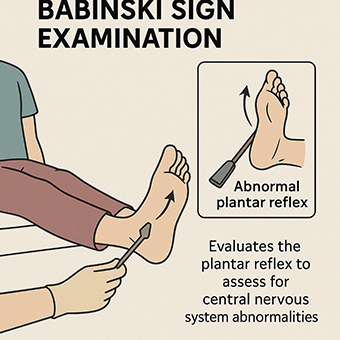Babinski Sign Test: A Central Nervous System Examination
The Babinski sign test is a crucial neurological examination used to evaluate the plantar reflex and identify potential abnormalities in the central nervous system (the brain and spinal cord). It is particularly useful for diagnosing damage to the corticospinal tract, which is a major motor nerve pathway.

How the Test is Performed
A healthcare provider uses a blunt instrument (such as the end of a reflex hammer) to firmly stroke the outer sole of the patient’s foot, moving from the heel toward the toes.
Normal Response (Negative)
In healthy adults and children over the age of two, the toes will curl downward. This is known as a flexor response.
________________________________________
Abnormal Response (Positive)
A positive Babinski sign occurs when the big toe extends upward (dorsiflexion) and the other toes fan out. This indicates a problem with the central nervous system, specifically damage to the upper motor neurons.
Important Note: A positive Babinski sign is considered normal in infants under two years of age because their nervous system is not yet fully developed. The reflex naturally disappears as they grow.
________________________________________
Medical Conditions Associated with a Positive Babinski Sign
If a positive Babinski sign appears in an adult, it may suggest a central nervous system disorder such as:
• Stroke: Damage to a specific area of the brain affecting motor nerve pathways.
• Multiple Sclerosis (MS): An autoimmune disease that damages the myelin sheath covering nerve fibers in the brain and spinal cord.
• Spinal Cord Injury: Trauma to the spinal cord that disrupts nerve signal transmission.
• Brain Tumor: A tumor in the brain that puts pressure on or damages the motor nerve pathways.
• Meningitis: Inflammation of the membranes that cover the brain and spinal cord.
• Amyotrophic Lateral Sclerosis (ALS): A progressive neurodegenerative disease that destroys motor neurons.